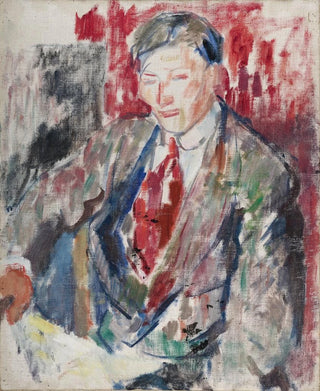Art print | Portrait of Karel Wouters - Rik Wouters


View from behind

Frame (optional)
The "Art print of Karel Wouters Portrait" is an iconic work by the Belgian painter Rik Wouters, distinguished by his bold approach and artistic sensitivity. This representation, which captures the very essence of his subject, goes beyond a simple image; it evokes a story, a personality, and a period. By immersing oneself in this piece, the viewer is invited to explore the nuances of human life and emotions, while witnessing Wouters' creative genius. The light, colors, and textures intertwine to create a rich and immersive atmosphere, perfect for contemplation.
Style and uniqueness of the work
Rik Wouters' style is often characterized by a blend of realism and impressionism, where the painting technique serves expression. In "Art print of Karel Wouters", the artist manages to capture not only the physical features of his model but also their inner essence. The fluid and dynamic brushstrokes breathe vibrant life into the canvas, while the chosen color palette evokes deep emotions. Every detail, from the piercing gaze to the delicately worked shadows, demonstrates impressive technical mastery. This portrait does not merely depict; it engages in dialogue with the viewer, inviting them to feel and reflect.
The artist and his influence
Rik Wouters, a key figure in Belgian art of the early 20th century, established himself through his unique style and artistic vision. Influenced by contemporary movements of his time, he integrated innovative elements while remaining true to his roots. His work, often focused on themes of daily life and portraits, reveals rare sensitivity and an ability to transcend mere visuals. Wouters also played a pivotal role in the evolution of art in Belgium, inspiring many artists through his explorations of color and light. His legacy endures, and each work, such as the "Art print of Karel Wouters", bears witness to this creative richness and quest for authenticity.
An exceptional wall decoration signed by Artem Legrand
In the context of interior decoration,

Matte finish

View from behind

Frame (optional)
The "Art print of Karel Wouters Portrait" is an iconic work by the Belgian painter Rik Wouters, distinguished by his bold approach and artistic sensitivity. This representation, which captures the very essence of his subject, goes beyond a simple image; it evokes a story, a personality, and a period. By immersing oneself in this piece, the viewer is invited to explore the nuances of human life and emotions, while witnessing Wouters' creative genius. The light, colors, and textures intertwine to create a rich and immersive atmosphere, perfect for contemplation.
Style and uniqueness of the work
Rik Wouters' style is often characterized by a blend of realism and impressionism, where the painting technique serves expression. In "Art print of Karel Wouters", the artist manages to capture not only the physical features of his model but also their inner essence. The fluid and dynamic brushstrokes breathe vibrant life into the canvas, while the chosen color palette evokes deep emotions. Every detail, from the piercing gaze to the delicately worked shadows, demonstrates impressive technical mastery. This portrait does not merely depict; it engages in dialogue with the viewer, inviting them to feel and reflect.
The artist and his influence
Rik Wouters, a key figure in Belgian art of the early 20th century, established himself through his unique style and artistic vision. Influenced by contemporary movements of his time, he integrated innovative elements while remaining true to his roots. His work, often focused on themes of daily life and portraits, reveals rare sensitivity and an ability to transcend mere visuals. Wouters also played a pivotal role in the evolution of art in Belgium, inspiring many artists through his explorations of color and light. His legacy endures, and each work, such as the "Art print of Karel Wouters", bears witness to this creative richness and quest for authenticity.
An exceptional wall decoration signed by Artem Legrand
In the context of interior decoration,






